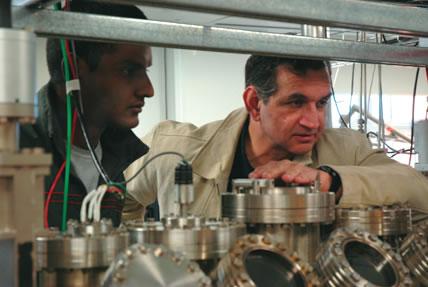Unlocking the Power of the Sun

“It’s impressive to see how many people on this campus are involved in renewable energy and how many are using sunlight as a source of that energy,” said Dr. Michael Fiddy, director of the UNC Charlotte Optoelectronics and Optical Communications Center. “The theme of our annual symposium this year was the role of optics in technologies for renewable energy. We had an amazing number of campus faculty who presented their research in this field.” (opticscenter.uncc.edu)
Photovoltaics is the field of research related to the conversion of sunlight into electricity. With increasing demand for clean energy sources, the need to expand and improve photovoltaic capabilities has grown greatly in the last few years.
UNC Charlotte is fortunate to have one of the world’s prominent experts in the field of photovoltaics in the person of Dr. Ray Tsu. “Dr. Tsu is extremely well known for his research in a number of areas, including solar power,” Dr. Fiddy said.
A distinguished professor in the Electrical and Computer Engineering Department, Dr. Tsu was the leader for many years of the Department of Energy’s photovoltaic efforts at the Solar Energy Research Institute. Dr. Tsu is also one of the world’s leading researchers in the areas of quantum properties of materials and device physics.
A number of UNC Charlotte researchers are looking at ways to improve existing photovoltaic technology. One is ECE professor Dr. Mohamed-Ali Hasan.
Dr. Hasan, along with his students and colleagues in the Crystal Farm Lab, are testing two ways to improve the efficiency of photo cells. The first method involves the deposition of materials with different bandgaps on silicon.
“Silicon has a poor response to infrared and ultraviolet light, which comprise more than 50 percent of the incident sun light,” Dr. Hasan said. “Our new method lets us integrate individual layers of material, each of which have an optimum response to a range of incident sun light, where silicon has poor response. This makes the solar cells much more efficient than just silicon. It is very efficient, but also more expensive to produce.”
Dr. Hasan is also working with Dr. Fiddy to develop a more cost-effective, but less efficient method. In this method, they are working on improving light capture by silicon and down-converting/up-converting wasted light using special nano-particles.
ECE professor Dr. Ed Stokes is looking at ways of applying his research in light-emitting diodes to photovoltaics. “In our LED, work we take electric current and convert it to light,” Dr. Stokes said. “Now we’re looking at doing the opposite; collecting light and turning it into electricity.”
The research involves elongating nanostructured active layers. “It’s easy to generate charge from photons,” Dr. Stokes said, “but it’s hard to then get the charge out where you can use it. We’re developing methods for applying nanowires in large arrays across photo cells. The nanowires are like blades of grass sticking up, and their roots are the channels for collecting the electrons.”
A different approach in harnessing the power of the sun is the work of Dr. Gloria Elliott of Mechanical Engineering. Her research involves making biofuel from the oils derived from algae.
“We are working with photosynthetic algae, which are essentially living solar cells,” Dr. Elliott said. “They are actually nature’s most-efficient solar cells. To grow them, we need bioreactors that contain water, CO2, trace amounts of minerals and sunlight.”
To process the algae for fuel, Dr. Elliott is looking at a variety of techniques, seeking to use the least energy possible to get the most energy out.
Other UNC Charlotte faculty members involved in photovoltaic work include Chemistry professor Dr. Jordan Polar. He is working with single-walled carbon nanotubes as the central part of a novel light-harvesting system.
Dr. Ken Gonzalvez of the Chemistry Department is developing new chemically amplified photosensitive polymers for capturing photons.
Dr. Thomas Suleski of Physics and Optical Science is using diffractive optics and refractive micro-optics to develop better ways of capturing light in solar cells, which in turn will help with routing the electrical current out.
For more information, contact Dr. Fiddy at mafiddy@uncc.edu.